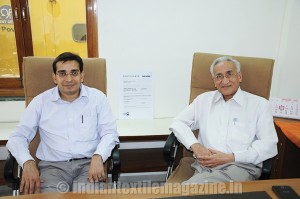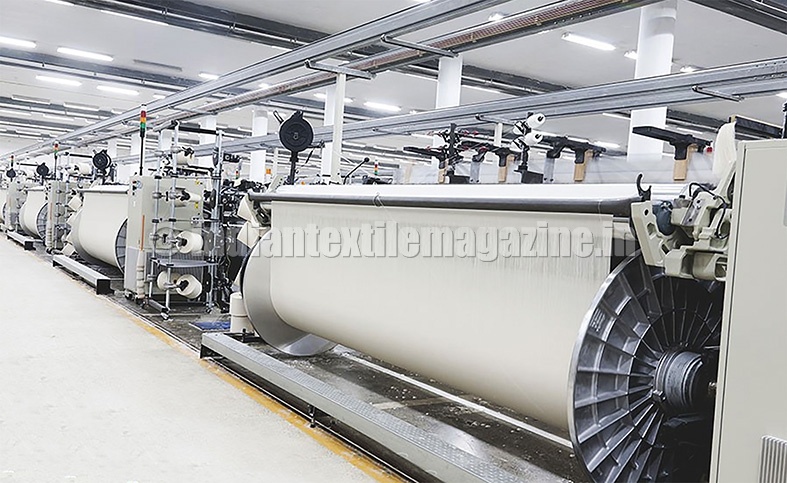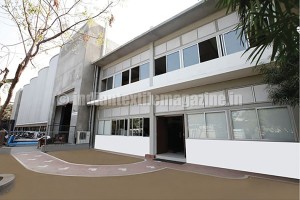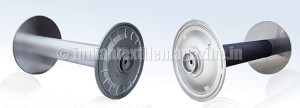By Arun Rao
Set up in 2011, the Ahmedabad-based Bharat Beams Pvt. Ltd. producing quality warper and weaver beams is the successor to Bharat Bobbins Ltd., which first started producing beams in 1981 and was the first manufacturer in India to produce the “Atlas” type hollow flange warper beams for direct warping machines, the know-how for which came from W. Schlafhorst & Co. of Germany.
In a chat with The Textile Magazine, Mr. JC Panchal and his son, Mr. Snehal Panchal, Directors at Bharat Beams, explained the intricacies of manufacturing beams, which for a layman might look like a child’s play. But, in the words of the senior Panchal, years of research and development go into making beams compatible for working smoothly on high-speed warpers and airjet looms.
Mr. JC Panchal was with Bharat Bobbins from the very beginning when the beams division was set up. He was involved in designing dies and other tools in the early days and still is involved in doing research and development related to developing even better quality beams.

Mr. Snehal Panchal joined the beams division in 1998 and has now over 16 years of experience under his belt. According to him, the beams produced can be found in most of the major textile mills across India and also in small weaving units with just 8-10 quality weaving machines.
The beams are also used as OEM equipment by warping and weaving machine producers not only in India but also in Italy and Germany. It seems these manufacturers also refer Bharat beams to their customers. The company exports 30-35 per cent of its production.
As far as beam production is concerned, the company follows international norms, and its production facility is ISO 9001:2008 certified. Besides, it also has a CE certificate.
Bharat Beams maintains strict quality and tolerance standards specified by warping and weaving machine manufacturers, which has led to the beams finding acceptance among quality beam users.
“Even small weaving and warping machine users are opting for our beams, although they are sold at a premium in comparison to similar beams sold in the market, for the simple reason that we maintain stringent quality standards and are producing them only to specified international standards. All the raw materials that we use are virgin metals, and we do not take even one per cent of scrap,” says Mr. Snehal Panchal.
Warper beams run at speeds of around 800-1,200 metres per minute on a direct warping machine. Beams manufactured as per international norms run without any vibration. If it is manufactured without taking tolerance levels into consideration, the warper will have to reduce the operational speed of the warping machine. This means lower productivity, and if speed is not reduced, beam vibrations will result in damage to the head stock.
After repeated usage, there is also a possibility that flanges of a low quality beam will bend, which, in turn, reduces the life cycle of the beam. So, according to the senior Panchal, the cost of buying new flanges is less than the cost difference between the quality beams sold by the company and its rivals in the field.
Mr. Snehal Panchal adds: “This has led to even small weavers realising the value of buying quality beams and not treating beams as just another accessory. If a weaver is buying a weaving machine costing around Rs. 25-30 lakhs and if, alongside, he buys low quality beams, they will not run properly on the machines, resulting in productivity losses as also in compromising on fabric quality. Bharat Beams has also found favour with the word of mouth spread from both warpers and weavers.”
For the uninitiated, there are four quality class beams, beginning from Q1 to Q4. Q1 is meant for 100 per cent cotton, spun yarn or blended with man-made fibres; Q2 is for yarns made from silk, viscose acetate and other man-made fibres; Q3 is for 100 per cent filament yarn but in relaxed condition; and Q4 is for 100 per cent filament yarn, but in unrelaxed condition and mainly used for draw warping machines.
The company also manufactures beams for technical textiles of upto widths of 540 cm and flange diameter of 1250 mm. Its integrated manufacturing plant carries out almost all processes in-house. A beam has 3-4 base components like beam barrel, flanges, driving mechanism and, in case of weaver beams, even a gear.
Bharat Beams has its own aluminum foundry casting flanges. Again for flanges, it has complete turning capacity as well as special buffing machines to buff the flanges from inside. It procures a majority of its pipes from either Jindal or Welpsun, both renowned names in the field.
The other processes like welding of pipes with automation, machining and zinc plating of barrels are done in-house. As far as hubs are concerned, there are automated machines for turning as well as teeth-cutting. The company inspection engineers check each of the components before being assembled. For producing warper beams, there are two computerised dynamic balancing machines. Each and every beam produced has a specific identity number and also specific inspection report.
When quizzed on the year gone by, Mr. Snehal Panchal said a number of orders were received during the year. For 2015, the order book position is for nearly five months, thanks to either the greenfield projects being set up or expansion undertaken by the existing mills.
Bharat Beams is an OEM supplier to various Italian and German textile machine manufacturers, who in turn export their beams to several countries across the world. Bharat Beams also directly exports to Latin America, South-East Asia, Indonesia, Taiwan, Nigeria, South Africa and China. Most of the export orders are received from customers on the direct recommendation from the OEMs to whom they supply beams.
He said that the company relationship with warper and weaving machine producers is extremely cordial because of their quality and technology. They are also a preferred weaving and warper beams supplier to major technical textile producers.
“Since we strictly follow global norms, our product quality is nowhere inferior to any of the top global players. However, we score on price basis, as we are very cost competitive,” he added.
On the scope for using alternative materials, Mr. JC Panchal observed: “We have a well-equipped R&D department which I oversee directly. We conduct trials on a continuous basis on different alloys and metals. The idea is to use alternative materials and get the same strengths but at a competitive price. There are good metals that provide the same wear and tear properties and also the same strength. But we can come out with a better value proposition, a benefit which can be passed on to customers.”
Bharat Beams manufactures warper beams which have a smooth flange surface outside or can also be called aerodynamic design to reduce energy consumption. With ribbed flanges, a warper beam which rotates at 800-1,000 metres per minute will create air turbulence which, in turn, affects the performance and productivity of the machine. This design is the USP of the warper beams.
When the new plant was set up in 2011, Bharat Beams expanded capacity from what it already had at Bharat Bobbins. In 2014 alone, sales crossed 3,000 beams as against around 2,200-2,300 beams at Bharat Bobbins. There is still further scope for expansion since enough space and infrastructure are in place. They too are currently in the research and development stage for a new range of quality beams which have so far not been manufactured in the country.


